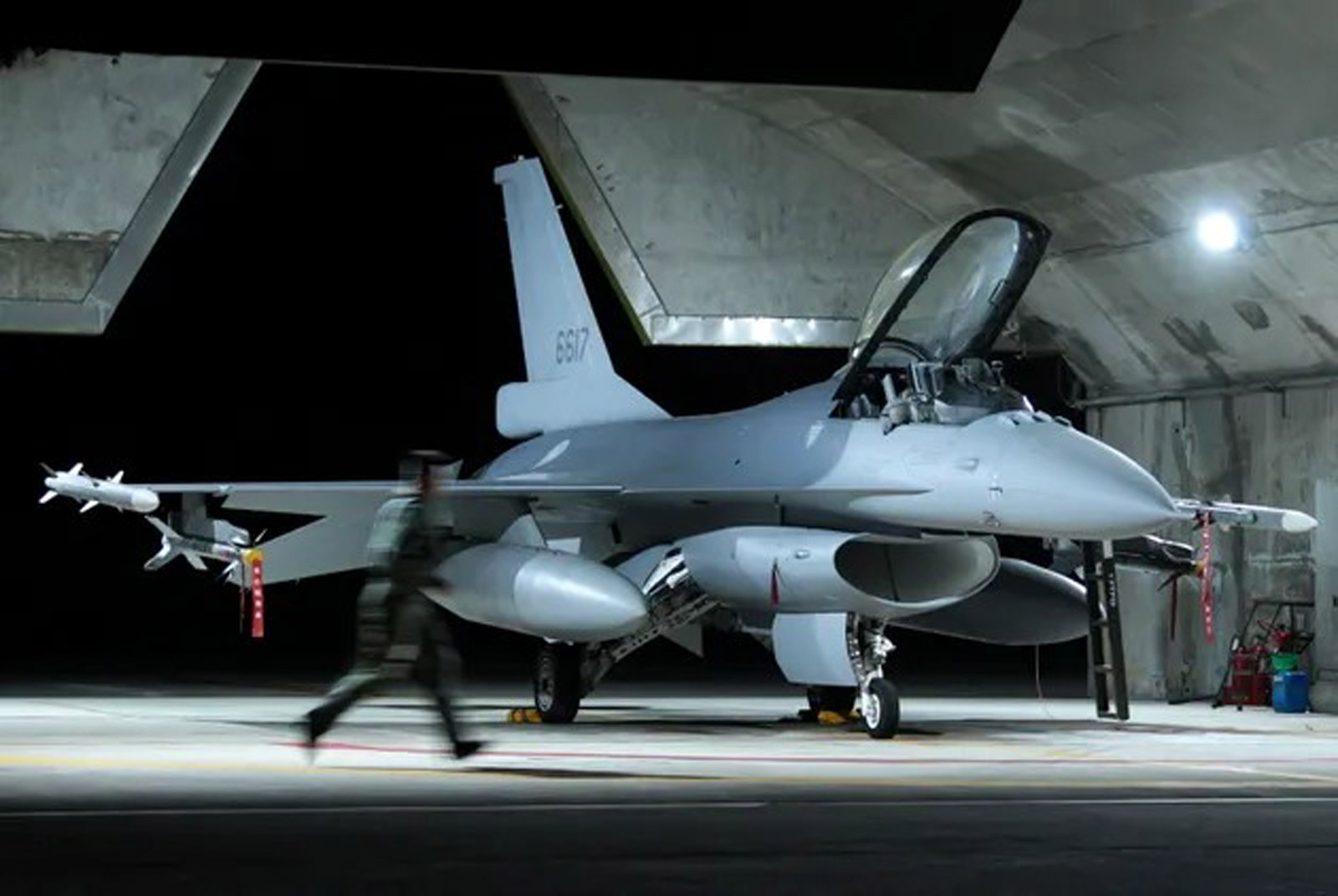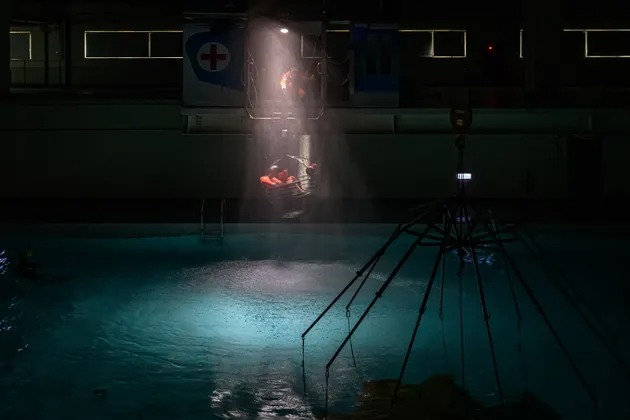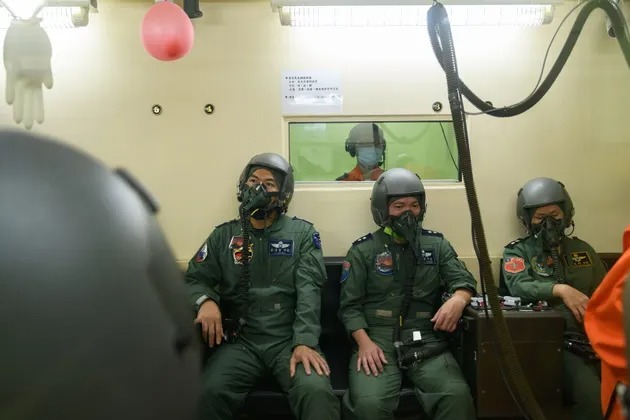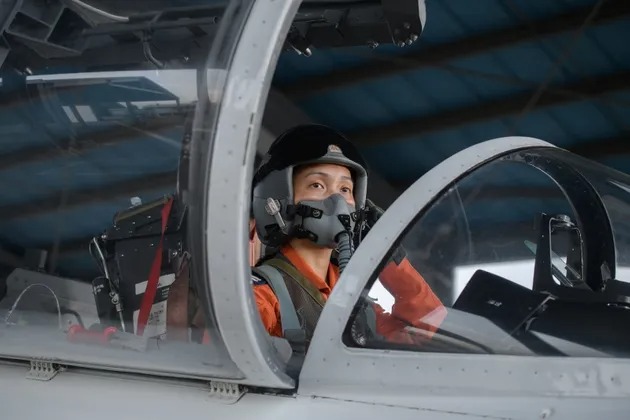Video report: Is Taiwan’s Air Force ready to meet China’s threat?

Source:Zi-Yao Yu
The growing menace of China’s military aircraft is putting pressure on Taiwan’s Air Force, highlighting potential weaknesses related to the Air Force’s fleet, pilots, and reserve force. Is Taiwan ready to deal with these issues?
Views
Video report: Is Taiwan’s Air Force ready to meet China’s threat?
By Ching Fang WuFrom CommonWealth Magazine (vol. 755 )
Lieutenant Colonel Hsu Yu-lun (徐煜倫), a member of the 5th Tactical Composite Wing stationed at Hualien Air Force Base, is one of them.
“Scramble!” As soon as the alarm sounds, Hsu puts on his gear, runs out of the security office, jumps in his plane, and goes through his pre-flight checks. Within six minutes, the engine of his F-16V is roaring across the sky.
Thousands of meters into the atmosphere, where the air has thinned and only the sea, sky and floating clouds are visible to the naked eye, Hsu gets on his radio to try to drive off People’s Liberation Army (PLA) military aircraft from the People’s Republic of China.
“Attention. You have entered our airspace and are affecting our flight safety. Turn around immediately and leave,” Hsu says.
This scramble drill has been a normal routine for Air Force pilots over the past two years. Since September 16, 2020, when two PLA anti-submarine aircraft first flew into Taiwan’s air defense identification zone (ADIZ), the frequency of Chinese intrusions has steadily grown. Nearly 900 PLA aircraft have entered Taiwan’s ADIZ so far this year, and that number will almost certainly top 1,000 by the end of the year.
The range of the PLA maneuvers has also expanded. From September 2020 to July 2022, Chinese military aircraft crossed the median line of the Taiwan Strait – the unofficial maritime border between Taiwan and China – a total of three times. Their sorties were instead concentrated in the southwestern corner of Taiwan’s ADIZ, northwest of the Pratas Islands.
Growing menace
But a day after the 19-hour visit of U.S. House Speaker Nancy Pelosi to Taiwan ended on August 3, China launched live-fire drills in six locations around Taiwan. Even after they ended, PLA fighter jets continued to breach the median line on a daily basis, and while they did not enter Taiwan’s territorial airspace, the attempt at intimidation was unmistakable.
Former Air Force General Hsiung Hou-chi (熊厚基) revealed in April that “air sorties are up 50% from the past.”
“And it will get worse in the future,” warned Shu Hsiao-huang (舒孝煌), an associate research fellow at the Institute for National Defense and Security Research.
He said that with pilots on the front lines of this dangerous balancing act, the Air Forces of Taiwan and China are entering a real endurance test.
In terms of global fleets, Taiwan’s Air Force is considered to be quite strong. According to the 2022 World Air Forces directory issued by online aviation media FlightGlobal, Taiwan is capable of deploying two percent of the world’s fighter jets, ranking 10th in the world.
That does not include the 66 new F-16V fighters ordered from the United States three years ago. In the not-too-distant future, Taiwan will have 206 F-16V aircraft, giving it more F-16Vs than any country in the world other than the United States.
Yet the numbers do not tell the whole story. CommonWealth visited four military sites to take a more in-depth look at the state of Taiwan’s Air Force.
Location No. 1: AIDC Shalu Complex
Complete upgrades for all military aircraft, ‘no time to waste’
The “V” in the F16-V stands for viper, a venomous snake and also the designation of the latest upgrade package for the F-16, the best-selling aircraft in military history. The first location in the world outside of the U.S. to carry out the F-16 upgrade is in Shalu District, in Taichung, home to Taiwan’s aerospace leader Aerospace Industrial Development Corporation (AIDC).
 (Source: Pei-Ying Hsieh)
(Source: Pei-Ying Hsieh)
With the support of consultants from Lockheed Martin, the F-16’s original manufacturer, Taiwanese engineers work in three shifts around the clock to complete structural modifications of the fighters by the end of 2023.
“Facing the threat of Communist China, we have no time to waste. Fighter jets’ availability rates equal combat power,” said AIDC Chairman Hu Kai-hung (胡開宏), who has an Air Force background and was vice chief of general staff of Taiwan’s military before taking his position at AIDC in March of 2019.
“These upgrades are creating something new from the old,” added AIDC President Ma Wan-june (馬萬鈞).
For the F-16s AIDC works on, every screw is disassembled and inspected, every system and component has to be maintained or rehabilitated, and new radar with better search and detection capabilities is installed. Once a F-16 has been fully refitted, it is tested by a test pilot approved by Lockheed Martin, and must meet the standards of a new fighter jet before it can be deployed by the Air Force.
Taiwan’s orders for the new F-16Vs and the upgrading of its older F-16s will cost a combined NT$390 billion. AIDC took advantage of the large order to build a maintenance and repair center for those planes. Among its tasks will be to use more parts made in Taiwan, such as wire harnesses and pipe fittings, to reduce dependence on parts from the U.S., but that will require sending domestically produced components to Lockheed Martin for certification.
 (Source: Pei-Ying Hsieh)
(Source: Pei-Ying Hsieh)
The real challenge
Procuring or making parts poses its own challenges, but these pale in comparison to the difficulties of recruiting the large number of new fighter pilots needed to fly the expensive new fighter jets.
Using a rough calculation based on the number of fighter jets in Taiwan’s fleet, the Air Force has a front-line combat force of about 300 to 400 people, but that is not big enough. The Legislative Yuan has called out the Air Force twice over the past three years for having planes but nobody to operate them.
A report by the Legislature’s Budget Center found that the number of qualified F-16 pilots increased by 129 from 2011 to the end of August 2019, but 108 retired during that time, averaging out to a net gain of fewer than three pilots per year.
Once the F-16V aircraft are delivered in full in 2026, an additional 100 new pilots will be needed based on Ministry of National Defense (MND) regulations.
“The Air Force is consumed by expanding its fighter fleet and even adding new fighter wings, but it should first figure out how to solve the problem of the relatively low number of pilots,” the Legislative Yuan's Legislative Research Bureau said last year.
Adding 100 top-notch pilots represents the biggest challenge faced by the Air Force. “The only way may be to lower physical and training requirements,” suggested Chieh Chung (揭仲), a senior assistant research fellow with the National Policy Foundation.
Location No. 2: Republic of China Air Force Academy, Gangshan
Huge time/expense to develop fighter pilots
In the summer of 2021, the Chung Cheng Armed Forces Preparatory School announced that the average admission score of high school pilot students was 20.5, the lowest average score of any military student group, as has been the case for several years. The MND said that aside from the adverse impact on recruitment of the COVID-19 pandemic, the low scores were the result of the limited pool of students whose physiques meet the requirements for flight crews. It also noted that the main university institution for pilots, the Air Force Academy, was easing its standards, such as adjusting academic admissions standards and lowering vision requirements.
Yet even if the Air Force Academy’s student recruitment has met its quotas, as has been the case the past few years, this has not translated into combat-ready forces.
Every stage, from admission and training to joining a fighter wing, has performance thresholds, and roughly 50 percent of the students enrolled at the Academy fail to make it to graduation. That only complicates the process of developing a large pool of pilots, especially because it takes 10 years from the time they start at Chung Cheng prep school to being assigned to a base as a pilot.
At the same time, “veteran pilots, from majors to lieutenant colonels, the backbone of the flying force” are coming under increasing pressure, said Shu of the Institute for National Defense and Security Research.
Flight training has always relied on a “mentor-apprentice” system, Shu said, but with veteran pilots needing to be trained on the upgraded F-16V and having to scramble more frequently in response to PLA aircraft incursions, they will inevitably have less time to train new recruits.
At the beginning of the year, a Taiwanese Air Force pilot named Chen Yi (陳奕) was killed when his F-16V crashed in Chiayi County. The cause of the crash has yet to be determined, but Chen’s flying time in the F-16V had only averaged three hours per month during his 22 months with the air wing, well below the standard 12-15 hours per month for Category 1 Air Force pilots.
Former Air Force deputy commander Lieutenant General Chang Yen-ting (張延廷) suspected that Chen’s flying hours were limited by the frequency of missions flown by more experienced pilots.
 (Source: Pei-Ying Hsieh)
(Source: Pei-Ying Hsieh)
Elite of the elite
How rigorous is the training the pilots receive? At another physiological training center in Gangshan, a centrifuge is used to teach pilots how to stay conscious under pressure.
When fighter planes roll or dive at high speeds, they generate huge acceleration forces known as G forces. The F-16 can pull as many as 9 G’s in a mere half-second, tantamount to subjecting pilots’ bodies to pressures nine times their body weight and making it hard for them to even move their fingers.
These heavy G forces can trigger nausea and seriously compress pilots’ spines. They can also force blood to quickly concentrate in a person’s limbs, causing a lack of blood flow to the brain that can cause blackouts and losses of consciousness, leading to crashes.
Beyond those forces, fighter jet missions are extremely dangerous and feature technical maneuvers requiring quick reactions. Extensive training is needed to master these skills, and F-16 pilots proficient in English have the chance to hone their flying skills at Luke Air Force Base in Arizona.
 (Source: Pei-Ying Hsieh)
(Source: Pei-Ying Hsieh)
So to say that fighter pilots are the elite of the elite of Taiwan’s military is not an exaggeration.
Because they are in demand by private airlines capable of offering generous salaries, the military has had to increase pay to retain talent, and a pilot with the rank of lieutenant colonel now makes NT$250,000 a month, more than Taiwan’s defense minister.
 (Source: Pei-Ying Hsieh)
(Source: Pei-Ying Hsieh)
EVA Airlines pilot Duncan Teng (鄧文科), who retired from the Air Force 10 years ago, was once the resident leader of the Taiwan Air Force’s team at Luke Air Force Base, and he racked up 2,560 flying hours on F-16s over 15 years.
How much would it cost now for the country to produce another pilot like him?
“If we go by the U.S. standard for an experienced pilot of 1,000 flying hours, you’d need at least NT$1 billion,” Teng said.
Basic education at the Air Force Academy for pilots requires between NT$10 million and NT$15 million, and flight training at Chihhang AFB in Taitung is another NT$10 million, Teng said, but the most expensive part is the cost of fuel for missions after pilots are assigned to Air Force bases. There is also the cost of the many ground support crew members who are needed to help the pilot get the plane airborne, he said.
Location No. 3: 10 accidents, 16 dead
‘Screws have come loose’
As hard as it is to nurture fighter pilots, the frequency of accidents is particularly hard to accept.
One of them ended in a funeral at the Air Force Academy on June 17.
Second Lieutenant Hsu Ta-chun (徐大鈞), who had graduated from the Air Force Academy not long before, died when the AT-3 jet trainer he was flying on his own crashed in Kaohsiung in May. Taiwan’s president and defense minister both attended the funeral to pay their respects.
Such somber scenes have been repeated far too often. Over the past five years, nine Air Force aircraft have crashed, with eight pilots killed in the line of duty. Add the crash of a Black Hawk helicopter at the beginning of January 2020 in which Chief of the General Staff Shen Yi-ming (沈一鳴) was killed, and the total would be 10 crashes killing 16 people, the most deaths suffered by any Armed Forces branch.
“Personnel training needs to be strengthened,” Defense Minister Chiu Kuo-cheng (邱國正) said earlier this year while discussing the spate of accidents. However, the vast majority of reports on the crashes have been classified by the MND, leaving people on the outside in the dark as to what exactly caused them.
Documents released by the Control Yuan, the agency that investigates public agency or official wrongdoing, revealed some clues, however.
Some of them came in investigations of the military initiated by former Control Yuan member Pao Tsung-ho (包宗和).
In two cases, involving a Mirage 2000’s crash and disappearance in waters north of Taiwan in November 2017 and an F-16 crash into a mountain into northern Taiwan in June 2018 during a military exercise, the Control Yuan censured the Air Force and demanded improvements. In a report on the 2020 Black Hawk helicopter incident, it impeached an Air Force meteorologist and his superior officer.
“The Air Force is not lacking in SOPs and internal control mechanisms. It’s just that ‘its screws have come loose,’” Pao’s report said, indicating that the military’s SOPs and controls are not being thoroughly implemented.
The military demands discipline, but it was getting sloppy and not being detailed enough, and Pao felt the Air Force needed to face up to its flaws in execution and conduct a complete review.
 (Source: Pei-Ying Hsieh)
(Source: Pei-Ying Hsieh)
Another mounting problem is that “there are airplanes but nobody to fly them.” Experts have suggested that the military simplify its fleet to better handle increasingly frequent missions.
“In the next 10 years, the military should accelerate the retirement of the Mirage 2000 fighters and replace them with the newly purchased F-16Vs,” said the National Policy Foundation’s Chieh, arguing that with resources limited, the Air Force had to make hard choices
Location No. 4: Taoyuan International Airport
Is the Air Force’s greatest backup force here?
Many military pilots become civilian airline pilots after completing the minimum years of service required in the Air Force, leading to a running joke among retired aviators: The Air Force’s strongest force is based at Taoyuan International Airport.
This brain drain may be a source of levity for some, but it has real implications; the chain of knowledge passed on in the mentor-apprentice training system is being disrupted. A frontline instructor admitted privately that there are not enough flight officers to train new pilots.
Taoyuan Airport could perhaps serve as an important reserve for the MND at a time when manpower is so tight.
 (Source: Pei-Ying Hsieh)
(Source: Pei-Ying Hsieh)
When Teng was training Taiwanese pilots in the United States more than 10 years ago, he had a chance to observe the operations of the U.S. 944th Fighter Wing Air Force Reserve at Luke AFB.
The 944th Fighter Wing consists of retired pilots with combat experience who average more than 2,000 hours of flying time. The unit handles certain combat readiness missions as well as the training of new pilots, and has guidelines on the assignment of flight hours and missions based on whether a member of the fighter wing is working full-time or part-time.
Teng noticed that airline pilots who were retired military flight officers could serve as part-time reserve flight instructors to train young U.S. Air Force aviators, and he figured why not do the same in Taiwan.
In 2008, he pitched the idea to the MND and Legislative Yuan, but it went nowhere, and he decided to go into the civilian aviation sector instead.
“Once such specialized skills leave the military, they are lost,” said Teng, who despite being retired for 10 years still thinks about the reserve force concept.
Chieh backed the idea, arguing that of all military disciplines, Air Force pilots are most in need of a reserve system.
The military prioritizes rank and seniority, with experienced officers leading younger recruits, and it should set up an independent fighter wing with retired pilots given ranks and leadership positions based on their experience to avoid management issues that would occur by trying to reintegrate them into existing units.
In addition, getting retired training officers to return to their bases will require salaries comparable to those for active duty, a personnel expense that will necessitate changes to existing laws and new measures.
During World War II, Winston Churchill paid tribute to the Royal Air Force’s efforts to repel attacks by the numerically superior German Luftwaffe when he said, “Never in the field of human conflict was much owed by so many to so few.”
Today, hundreds of Taiwanese fighter pilots in single-seat cockpits who toil under pressure to keep their country at peace are facing a challenge of equal proportion.
Have you read
- Maps: China’s 72-hour ‘Taiwan blockade’
- Taiwan needs porcupine quills to deter China
- Pelosi’s Taiwan visit was a US-made crisis
Edited by TC Lin
Translated by Luke Sabatier
Uploaded by Penny Chiang, Ian Huang






